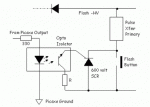davefish55
New Member
Hello - I am thinking about a project that would use a Picaxe to control the flash of a small throw away camera strobe. There are quite a few hacks on the net involving these (and ample warnings about how you can really zap yourself on the caps that are in the circuit). See --- http://members.misty.com/don/samflash.html --- for a huge amount of information.
I can't find anything that shows how to drive the switches from a Picaxe. One example camera strobe circuit diagram is attached. My question is how to best drive the switches (S1 - Charge and S2 - Fire in the attached circuit)?
Should I use a small relay (like the Picaxe example circuit) -- if so, what will the contact rating need to be - I think the voltage on the S2 leg is around 300V, but it is not clear if the switch passes the full voltage to the strobe and I can't find where the current is called out. When these relays are shown in example circuits, they don't seem to show a part number, any example parts?
Would a thyristor (triac?) be better -- what does the circuit look like for driving a triac? I've also seen a comment where triacs are "easy to turn on, but hard to turn off". Or should I be thinking SCR -- again, how does this device get driven off an axe? Or should I use a SSR - opto-isolated?
Excuse me if these are ignorant questions. I've been digging around for answers on this forum and elsewhere before I post, but have not found anything definitive. And these strobe circuits look tricky enough, that it seemed time to ask the experts.
Thanks for any input.
I can't find anything that shows how to drive the switches from a Picaxe. One example camera strobe circuit diagram is attached. My question is how to best drive the switches (S1 - Charge and S2 - Fire in the attached circuit)?
Should I use a small relay (like the Picaxe example circuit) -- if so, what will the contact rating need to be - I think the voltage on the S2 leg is around 300V, but it is not clear if the switch passes the full voltage to the strobe and I can't find where the current is called out. When these relays are shown in example circuits, they don't seem to show a part number, any example parts?
Would a thyristor (triac?) be better -- what does the circuit look like for driving a triac? I've also seen a comment where triacs are "easy to turn on, but hard to turn off". Or should I be thinking SCR -- again, how does this device get driven off an axe? Or should I use a SSR - opto-isolated?
Excuse me if these are ignorant questions. I've been digging around for answers on this forum and elsewhere before I post, but have not found anything definitive. And these strobe circuits look tricky enough, that it seemed time to ask the experts.
Thanks for any input.
Attachments
-
21.4 KB Views: 96


